 Project 611 (NATO “Zulu”) conventional attack submarines
Project 611 (NATO “Zulu”) conventional attack submarines
26 submarines 1952-57
Soviet Cold War Subs
Pr.613 Whiskey | Pr.611 Zulu | Pr.615 Quebec | Pr.633 Romeo | Pr.651 Juliet | Pr.641 Foxtrot | Pr.641 buki Tango | Pr.877 KiloPr.627 kit November | Pr.659 Echo I | Pr.675 Echo II | Pr.671 Victor I | Pr.671RT Victor II | Pr.671RTMK Victor III | Pr.670/670M skat Charlie | Pr.705 lira Alfa | Pr.949 antey Oscar | Pr.945 Sierra | Pr.971 bars Akula | Pr.885 graney Yasen | Pr. 545 Laika
Pr.629 Golf | Pr.658 Hotel | Pr.667A Yankee | Pr.667B Murena Delta I | Pr.667D Delta II | Pr.667BDR Kalmar Delta III | Pr.667 BDMR delfin Delta IV | Pr. 941 akula Typhoon | Pr.995 borei Dolgorukiy | Pr.09851 Khabarovsk
The Project 611 (NATO Zulu class) were an early postwar attack submarine class contemporary, but more developed than the Project 613 (Whiskey class) on their replication of all innovations found in the the WW2 German Type XXI U-boat. They saw a limited production at Leningrad of just 26 submarines, with longer range and given the hottest fleet assignments. They were also modified into many sub-versions up to the missile-armed Zulu V. In many ways, they were the blueprint for the mass-built 1970s Foxtrot class, 2nd generation attack submarines. #sovietnavy #sovieskayaflota #russiannavy #zuluclass #attacksubmarine
History
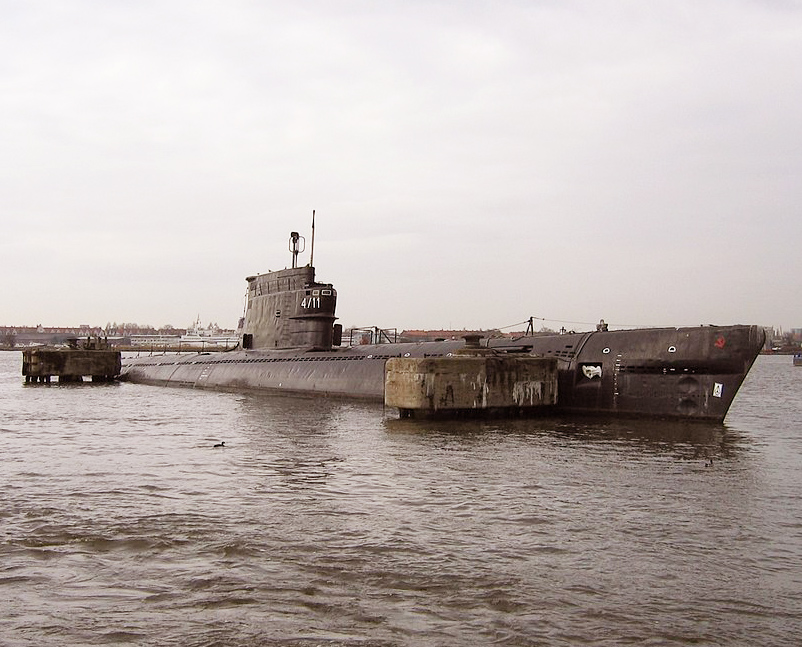
Work on a new generation of large submarines was already started in 1941, but interrupted during the Great Patriotic War. In 1942 a Large diesel-electric submarines, 2nd rank was planned. It was to be a further development of submarines of the “K” type (XIV< series) or “L” (II, XI, XIII series) and type “D” (I series). In 1943, work thus started on a new ocean-going submarine with long range. It was started at its own initiative by TsKB-18 NKSP, with several versions and preliminary designs.
In January 1944, the Main Directorate of Shipbuilding of the Navy wrote initial specifications (TTZ) for a large submarine, later approved by the Commander-in-Chief of the Navy. Egorov S.A. was appointed chief designer of the project. According to the specifications, it max depth was setup to 150 meters (492 ft), surface speed 22 knots, and submerged speed 9-10 knots. It was planned to install six bow 533-mm torpedo tubes plus space for 12 spare torpedoes, four stern 533-mm torpedo tubes with two spare torpedoes, one 100-mm and four 25-mm anti-aircraft guns.
In January 1946, many changes were made to the project, notably regarding artillery with a second 100 mm gun added on the other side of the conning tower, plus 37 mm AA guns. But at the same time, Sovit Engineers had their hands on the Type XXI and XXIII boats, and thus, it became desirable to make numerous adjustments to the design with a quest for mechanisms and devices to be unified with the Project 613 created in parallel. Thus the project of a large submarine was sidelined, then resumed with significant differences.
According to the new program of October 1946, it was planned for 10 years a construction program with the best options presented to the People’s Commissar of the Navy N.G. Kuznetsov. In 1948 the latter approved the large submarine project, which Supervision and preliminary technical design fell under the Central Research Institute of Military Shipbuilding (B.F. Morozov). The preliminary design was completed in October 1947, approved by a decree on August 2, 1948, then the full technical plans were completed in December 1948, approved by decree on January 28, 1949, which based on these plans, authorized the construction of project 611.
By order of the Civil Code of the Navy No. 95dsp, January 12, 1949 the new type was defined as follows:
1. Attacking warships and civilian vessels during independent actions on remote sea lanes and close to bases and ports.
2. Same but with with naval forces in fleet operations.
3. Perform independently operational reconnaissance missions in remote areas.
4. Mine laying on enely distant communications lines and in front of bases.
5. Landing sabotage and reconnaissance teams on shore close to enemy assets
These tasks needed to be done on all oceans, under all latitudes, by all visibility and sea conditions.
It was planned at TsKB-18 under chief designer S. A. Egorov with tasks such as ocean communications, attacks on enemy ships and protection convoys, minelaying, and long-range reconnaissance. There was a significant input from German Submarine designs, with many systems shared by the Project 613 (Whiskey) as they were designed and built simultaneously. One innovation was the use of external framing for a stringer pressure hull as well as bulkheading to create “safe zones” in case of flooding as well as a roomier internal layout and improvements of systems across the board.
Initially like for Project 613, the 611 were given artillery, between a twin deck 57mm aft, dual purpose, and twin 25mm AA guns forward. There were two snorkels, the first was later removed and the second added after entering service.
Production
Construction of the lead boat started on January 10, 1951 at Leningrad shipyard No. 196 (now Admiralty Shipyards). After completion she became the largest Soviet submarine ever, showned in news and inaugurated with a lavish ceremony. At this yard were built eight boats, B-61 to B-69. The last ship entered service on July 15, 1958. Construction also was carried out at Yard No. 402 Molotovsk (Severodvinsk) for 18 more, from B-70 to B-89. Severodvinsk became soon the USSR mecca for Soviet submarines, soon drawing the best designers and engineers and having the largest staffed design bureaus. Names were initially B-61 to B-82 and B-88 to B-91, but pennants changed frequently in the 1970s or 1980s to confuse NATO observers. NATO reporting names Zulu I through Zulu V referred to the five converted missile-firing submarines, excluding the prototype, so there were no Zulu II, III or IV. These subs served on the Baltic and Black sea only and most were later repurposed for non-combat purposes and stricken in the 1980s.
Design of the class

1. Nasal TA; 2. Bow torpedo (living) compartment; 3. Bow battery compartment; 4. Gyrocompass repeater; 5. CPU; 6. Aft battery compartment; 7. Diesel compartment; 8. Stern TA; 9. Electromotor
compartment; 10. Aft torpedo compartment; 11. Cylinders of the VVD system; 12. Buoyancy tank; 13. Receiver of the Mars station; 14. Chain box; 15. Central City Hospital No. 1; 16. CDC; 17. Nasal trim tank; 18. Tank distillate water; 19. Attack periscope mine; 20. Rapid submersion tank; 21. Leveling tank; 22. Diesel 37D; 23. GED PG-102; 24. Propulsion engine control panel; 25. Tire-pneumatic clutch; 26.Thrust bearing; 27. Economical ED; 28. Fuel tanks; 29. Aft trim tank; 30. Middle propeller shaft; 31. Conning tower; 32. Anti-aircraft periscope “Torch M01”; 33. Periscope attack; 34. Loop antenna; 35. BATH; 36. RDP device; 37. Antenna of the station “Nakat” (RTR)
Hull and general design
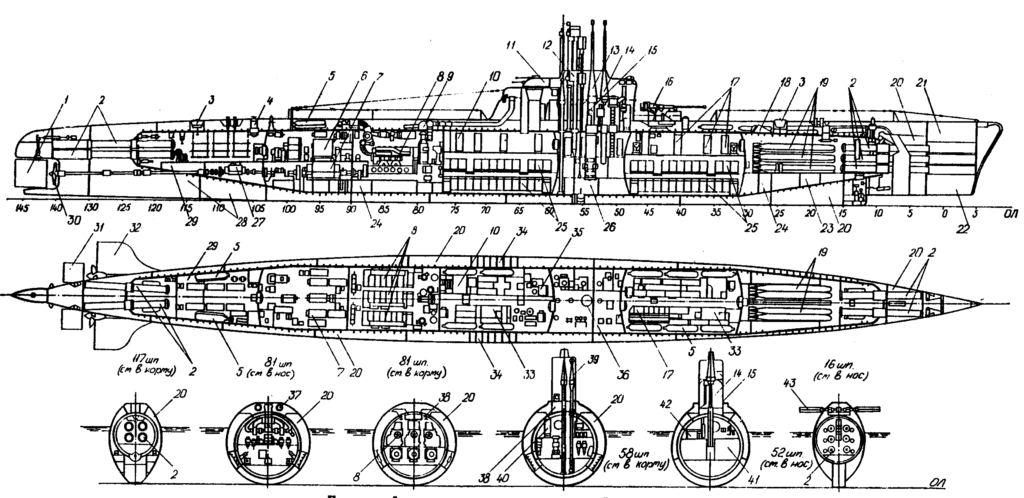
1 – rudder blade; 2 – torpedo tube; 3 – emergency telephone buoy; 4 – entrance hatch with tube; 5 – VVD cylinders; 6 – control panel for propulsion electric motors; 7 – propulsion motor; 8 –
engine 37D; 9 – external valve of the air supply shaft to diesel engines; 10 – galley; 11 – 25-mm artillery mount 2M-8; 12 – RDP device; 13 – attack periscope; 14 – anti-aircraft periscope;
15 – durable cabin; 16 – 57 mm artillery mount SM-24-ZIF; 17 – officer premises; 18 – torpedo-loading hatch; 19 – spare torpedoes; 20 – main ballast tank; 21 – tank
buoyancy; 22 – direction finder receiver; 23 – bow trim tank; 24 – fuel tank inside a durable housing; 25 – battery; 26 – quick immersion tank;
27 – electric motor of economic progress; 28 – double-sided fuel tank; 29 – aft trim tank; 30 – propeller; 31 – aft horizontal rudder; 32 – stabilizer;
33 – team room; 34 – surge tank; 35 – radio communication room; 36 – central post; 37 – air supply pipeline to diesel engines; 38 – RDP pipeline; 39 – active radar antenna
communications; 40 – torpedo firing control device; 41 – artillery store; 42 – navigator’s cabin; 43 – bow horizontal rudders.
The architecture retained remained a classic double-hull type with central chambers, robust cylindrical pressure hull with truncated cones made of new high-alloy steel of the SHL-4 type. The final design was 67.5 meters long for 18 to 22 mm thick and completely welded with the exception of removable plates to access batteries and machinery. These sections were connected with rivets or studs. Dimensions of the hull were far superior than for the Project 613 and it was possible to carry these on the White Sea-Baltic Canal on a special dock for such transfer, still. The heavy bulkheads in the pressure hull were cast and welded of 3.4 meters in diameter () amidship, down to 2.9 meters at the stern ().
The hull had a sharped front and end for best speed, and good seaworthiness with a tailored propeller. The lightweight external hull was “only” 3 mm thick, but reinforced by 8 mm longitudinal framing along the waterline as its top was far more rigid with the deck and narrow prow. It was calculated to endure moderate ice pression. The conning tower and deck had wave breakers to prevent heavy splashing and flooding of the bridge, calculated for conditions of up to a sea state 5-6. The hull had well refined and hydrualically tested shape for best performances both surfaced and underwater in almost any weather conditions.
She was equipped with an advanced snorkel, had 2 periscopes on rotating platforms, a radar for surface and air targets, and a radar signal detection station and state-of-the-art navigation system. Cylindrical welded strong hull was made of new high-alloy steel which thickness ranged from 18 to 22 mm, with external frames, not previously used on Soviet submarines. This made it possible to significantly increase internal volume making for seven compartments.
The Type 611 displaced as completed 1,875 tons (1905 metric tonnes) surfaced and 2,387 tons (2425 metric tonnes) submerged for 90 m (295 ft) in lenght, 7.5 m in beam, and 5.14 m in draught.
It had a double-hull, durable, streamlined as the Project 613 and inspired by the Type XXI, but divided into seven compartments, some closed by sold cast bulkhads creating “safe areas”:
The first compartment (bow torpedo) hosted the six torpedo tubes and 12 reloads on cradles
The second was the battery compartment below (first group), but its upper tier had the officers wardroom, sonar cabin and shower room.
The third compartment comprised the central post, with all command organs, access to the upper conning tower and retractable periscopic systems.
The fourth hosted on its lower tier the second battery group, on its upper tier foremen’s wardroom, radio room, storerooms, and galley.
The fifth was the machinery room, housing the three diesel side by side and diesel compressors.
The sixth housed the three main electric motors and transmission.
The seventh were the four semi-automated stern torpedoes with spares and personnel bunks, auxiliary electric motor at its the lower tier.
Powerplant
The Type 611 submarines were fitted with three 37D diesel engines (rated for 6,000 hp) coupled with three electric motors (5,400 hp): One PG-102 electric motor and two PG-101 electric motors. Total power was thus 6,000 hp and 5,400 (2,700 hp and two 1,350 hp). Top speed, surfaced, was 18 knots (33 km/h) and submerged 16 knots (30 km/h), which was not impressive when compared to the Type XXI, but still three knots better than the Project 613 boats. It was the same surfaced. Test depth was 200 m (656 ft) as the Type 613 boats, but 170 m operational.
They had a refrigeration unit, air conditioning and desalination plant. In the engine room, pneumatic tires were installed between diesel engines for cushion and reducing vibration and noises, whereas propeller shafts were even better insulated than on Project 613 boats. There was a disconnecting coupling system used as offering a clear advantage over the “Bamag” type couplings of pre-war submarines. This not only simpler and more reliable in operation, but also made it possible to install the shaft line during construction and not after launching. In general all mechanisms were installed on soundproofing shock absorbers. They ended as quiet as the “Whiskey” class (for the 1950s). In the 1970s it was not the same story !
Armament
Initially 6 bow and 4 stern 533-mm (21-inch) torpedo tubes, 22 torpedoes in all. Unlike the smaller Project 613, these had stern tubes. It was soon considered an obsolete feature and subsequent boats were built without. 12 spare torpedoes were also carried, located on racks. Instead these, some 32 mines of the AMD-1000 type were optional. Just like the Project 613 boats, they were completed at first with artillery: On the upper deck a twin 57-mm SM-24-3 3IF DP mount forward of the conning tower, and twin 25-mm 2M-8 anti-aircraft guns aft of the same CT, exaclty like for the Project 613 boats. It was soon realized more interesting to just be discretion, and when an aircraft was spotted by radar, diving rapidly to avoid detection. Thus in 1956, artillery was removed for all subs, and the drag they caused being lifted, their underwater speed increased by a knot.
Sensors
All serial boats were given a “Flag” radar, Tamir-5LS and Feniks sonars as well as the Nakat ECM suite.
B-61 was the only one having a Mars-24KIG sonar in addition to the rest. See also other variants.

Project 611, Zulu I, B37 as commissioned

Zulu V, B101 author’s 3D rendition from Mike1979Russia’s profiles, maintained under CC licence
⚙ specifications |
|
| Displacement | 1,875 tons surfaced, 2,387 tons submerged |
| Dimensions | 90 x 7.5 x 5.14m (295 ft) |
| Propulsion | 3 shafts diesel engines (6000 hp), 3 electric motors (5400 hp) |
| Speed | Surfaced: 18 knots (33 km/h), Submerged: 16 knots (30 km/h) |
| Range | 22,000 nm at 9.2 kts surf., 440 nm at 2.1 kts submerged* |
| Test Depth | 200 m (656 ft) |
| Armament | 6 bow, 4 stern 533 mm TTs, 22 torpedoes |
| Sensors | Flag radar, Tamir-5LS, Mars-24KIG sonars, Nakat ECM suite |
| Crew | 70 officers and men |
*projects V611 and AV611: 14350 nm at 9 kts surfaced or 290 nm at 2 kts submerged.
Modernization and variants
During operation, the Zulu class were repeatedly modernized, such as the B611 for testing ballistic R-11FM missiles, AV611 modified В611, serial production, PV611 to test the S4.7 missile, P611 to tests the P-10 missile system, 611RA to test the Radian-1 mine detector sonar, AV611C to test the “Symbol” astrocorrector prototype for navigation, AV611E to test the Yenisei SJSC, 611RU for the SJSC “Rubin”, 611RE for the hydroacoustic towed antenna “Rassvet” and the SJSC “Kerch”, AV611K for a new satellite navigation “Shtyr-M” system or as a control ship), AV611TS for satcom system “Tsunami-B”, AV611D for measuring and monitoring physical fields or experimental minelayer for NATO, 611P mothership for autonomous manned vehicles with the very close BS-82, never built.
Also 611RE (Project 611Р) only listed, as well as UTS-611 (training station sub) and B-79 project for AV611 for scientific purposes.
A611/611M were TsKB-18 submarin projects with improved characteristics no gun armament as new torpedoes.
Project 631 was a preliminary design of the 611 with increased autonomy developed in 1954 by TsKB-18
AV611D7 was another 1962 TsKB-16 developement to fire the D-7 missile system on paper, never completed, as specifications were not issued.
AV611 was a 1968 TsKB-16 experimental submarine to test P-120 Malachit SSN. One AV611 was allocated but not tested. Eventually, this missile was test edon a 670M SSGN.
Project 611-bis only stayed at preliminary design stage with new equipments and AIP
However four submarines were used for long-distance cruises, named Lyra, Orion, Mars and Vega for scientific purposes, and without significant modifications.
Modifications per submarine


In 1957-1960, all Project 611 had their artillery removed. In 1957 B-64 was modified under P611, her spare torpedoes were removed and a single P-10 SSM was installed. She was returned to initial state in 1959. The next year, B-62 was modified under Project AV611.
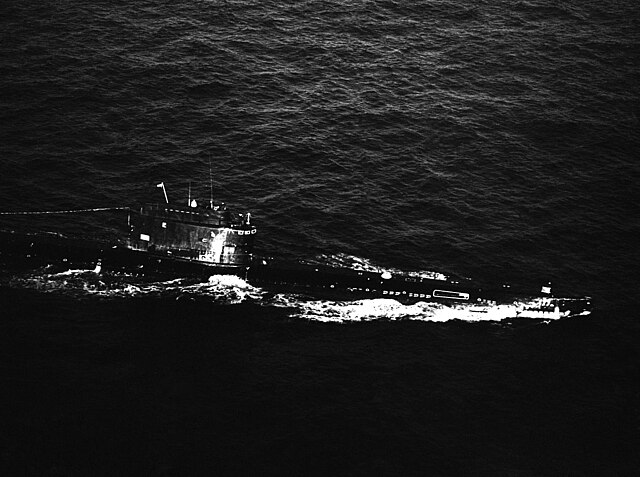
Zulu IV in patrol, 1988
In 1960 B-67 was modified under Project PV611 (1,890/2,387t, 90.7×7.50×5.10m or 12.5kts, 3,650(8)/290(2)nm and two RF-11FM SLBM as well as one S4.7 SLBM test missile tube and in 1965 she underwent Project 611RA with the test missile removed and a Radian-1 sonar installed.
In 1966 B-71 under Project 611RU (disp. 1,865/2,348t, Tamir-5LS and Feniks sonars removed for the Rubin sonar for tests.
In 1966, B-68 was also modified to test sonars under Project 611RE, with the “Kerch” sonar and VDS Rassvet.
In 1969 B-78 renamed “Murmanskiy Komsomolets” was modified under Project AV611S with two R-11FM SLBM removed and addition of the Simvol astronavigation system, removed in 1973 for the installation science equipment.
The same year B-89 underwent Project AV611Ye also two R-11FM removed and all Torpedo tubes and a Yenisey and Luch sonars installed.
In 1970, B-73 under Project AV611K tested the Shtyr’-M satellite navigation system and B-79 (Project AV611Ts), the Tsunami-B satellite communication system.
In 1972, B-69 and next year B-891 were modified under Project 611P with the removal of remaining torpedoes and spared, for the addition of a diving equipment for spec ops and the ‘Arkhipelag’ or ‘Seliger’ submersible.
The world’s first ballistic submarines (Project AV 611):
picccc
Six of these as seen above became in 1956 the world’s first ballistic missile submarines: They were armed with a single R-11FM Scud missile. One was a prototype with a single tube, and five others had two Scuds each (NATO Zulu V). B-67 was the first to launch a missile on 16 September 1955, a first. At the same time, the USN was modifying GATO class subs into cruise-missile launching attack submarines (SSG). The Zulus are favourably seen as far more advanced and more capable than the cheap, simplified Project 613 for mass production and in many ways, became the base on which the next Project xxx (NATO Foxtrot-class) were developed as well as the Project 629 (NATO Golf I class) conventional ballistic missile submarines.
Main variants and conversions
Many Project 611 submarines were modified according to one project or another, usually to test new types of weapons and equipment:
B611: in 1953-1956, the B-67 received two vertical missile silos and was used for test firing of surface-launched R-11FM ballistic missiles, 8 launches were carried out.
AB611: according to the B611 project, revised based on the results of testing, with two R-11FM ballistic missiles, five submarines were converted and completed.
PV611: in 1958-1960, instead of two silos, the B-67 received one new one for test firing of the S4.7 ballistic missile (R-11FM with underwater launch).
AV611RA (611RA): in 1963-1965, the B-67 was converted to test the Radian-1 sonar mine detection station.
611RU: in 1963-1966, the B-71 was converted to test the MGK-300 Rubin sonar system, later installed on Project 661 and many other nuclear submarines.
611RE: in 1964-1966, the B-68 was converted to test the MGK-100 Kerch sonar system and the Rassvet towed antenna.
AV611S: in 1966-1969, the B-78 of project AV611 was converted to test the Symbol astrocorrector.
AV611E: in 1967-1969, prototypes of the Yenisei SJSC and the Luch GAS were installed on the B-89 of the AV611 project, later installed on the Project 705 nuclear submarine.
AV611K: in 1970, the B-73 received a prototype of the Shtyr-M space navigation system.
AV611TS: in 1969-1970, an experimental set of Tsunami-B space communications equipment was installed on the B-62.
AV611D: in 1972-1973, the B-78 received the Dniester equipment for studying hydroacoustic fields and the wake of surface and submarine ships.
611P: in 1968-1978, three boats were converted into carriers of deep-sea vehicles of the Archipelago and Seliger systems.
P611: in 1956-1957, the B-64 received a launcher for the P-10 cruise missile.
Project AB611
Under the leadership of chief designer N.N. Isanin, a modification of Project 611 was developed, designated “B-611”. The project included equipping the boats with two R-11FM nuclear ballistic missiles, located in an extended wheelhouse. One boat was modified – B-67. After its modification, according to the modified project, which received the designation “project AB611”, the designations “A611” or “611AV” are also found in the literature; 5 more boats were modified: B-73, B-78, B-79, B-89 , B-62.
Project “Lyra”
One of the submarines was converted to conduct scientific research in the field of naval science.
The Zulu class in service
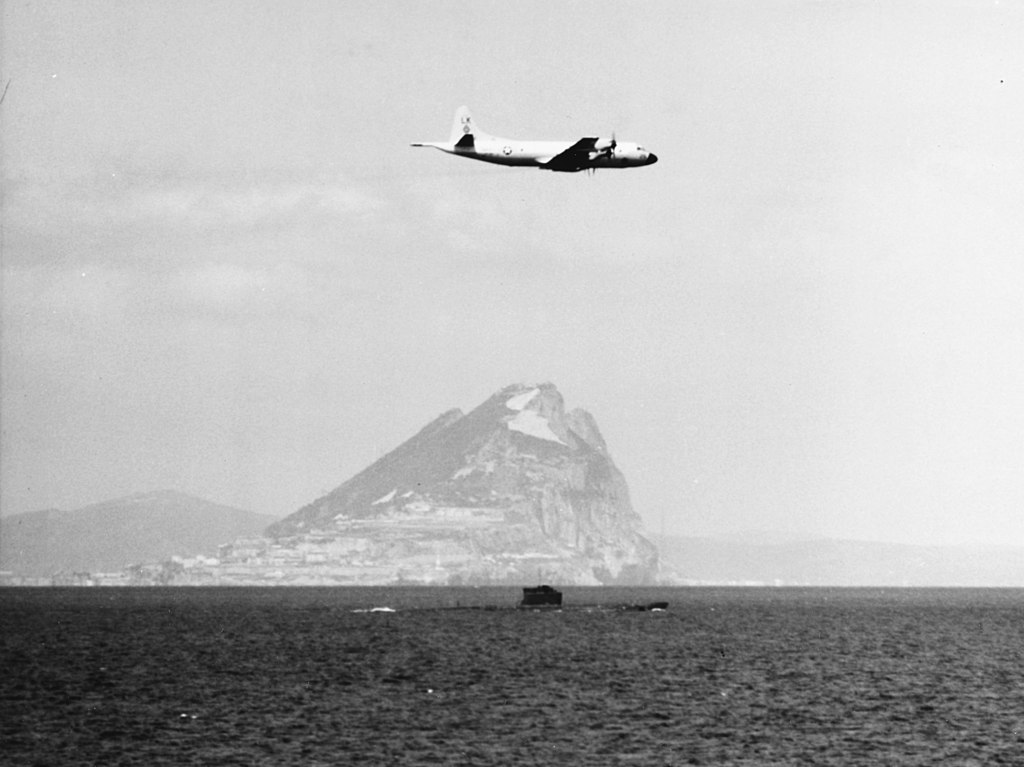
P3 Orion from VP-26 fly over a zulu class off Gibraltar, April 1969
As seen above, the Project 611 were much costier and larger than the Project 613 but apart submerged speed and range, did not offered much advantages. Modifications started early on and went on all along the 1970s, retiring quite a number of active boats for tests. They were all retired in 1978-1982 apart some prototype conversions which dragged for a bit longer, notably for scientifical applications. Here are career records:
 B-61 (Serial number 580)
B-61 (Serial number 580)
Laid down on January 10, 1951 at the Sudomekh plant (No. 196), Leningrad. Launched July 26, 1951, entered service December 31, 1953. In 1978, it was withdrawn from the fleet.
 B-62 (Serial number 631)
B-62 (Serial number 631)
Laid down on September 6, 1951 at the Sudomekh plant (No. 196), Leningrad. Launched April 29, 1952, entered service December 31, 1953. In 1966, she participated in testing sonar equipment. In 1970, she was decommissioned, stricken from the fleet.
 B-63 (Serial number 632)
B-63 (Serial number 632)
Laid down on February 6, 1952 at the Sudomekh plant (No. 196), Leningrad. Launched July 18, 1952, entered service June 30, 1954. In 1970, renamed B-863.
 B-64 (Serial number 633)
B-64 (Serial number 633)
Laid down on May 15, 1952 at the Sudomekh plant (No. 196), Leningrad. Launched November 29, 1952, entered service December 30, 1954. In 1957, she was converted at plant No. 402 (now the Central Automatic Plant of the Russian Federation “Sevmashpredpriyatie”, Severodvinsk) into a missile submarine (project P-611). In 1957, she participated in comprehensive tests of missile weapons and made four launches. In 1958, she was converted back into a torpedo boat (according to Project 611). In 1978, she was decommissioned, stricken from the fleet.
 B-65 (Serial number 634)
B-65 (Serial number 634)
Laid down on July 24, 1952 at the Sudomekh plant (No. 196), Leningrad. Launched March 21, 1953, entered service December 6, 1954. In 1978, she was decommissioned, stricken from the fleet.
 B-66 (Serial number 635)
B-66 (Serial number 635)
Laid down on December 15, 1952 at the Sudomekh plant (No. 196), Leningrad. Launched June 30, 1953, entered service December 29, 1954. In 1970, renamed B-866. In 1979, she was decommissioned, stricken from the fleet.
 B-68 (Serial number 637)
B-68 (Serial number 637)
Laid down on June 6, 1953 at the Sudomekh plant (No. 196), Leningrad. Launched October 31, 1953, entered service November 27, 1955. In 1980 she was decommissioned, stricken from the fleet.
 B-69 (Serial number 638)
B-69 (Serial number 638)
Laid down on September 14, 1953 at the Sudomekh plant (No. 196), Leningrad. Launched June 18, 1954, entered service December 31, 1955. In 1989 she was decommissioned, stricken from the fleet.
 B-67 (Serial number 636)
B-67 (Serial number 636)
Laid down on March 26, 1953 at the Northern Machine-Building Enterprise (No. 402), Severodvinsk. Launched September 5, 1953, entered service June 30, 1956. On September 11, 1955, the flag of the USSR Navy was raised on the submarine. On September 15, 1955, the B-67 made shes first trip to sea. Commander Captain 2nd Rank F. Kozlov. On September 16, 1955, at 5:32 p.m., for the first time in the world, a ballistic missile was successfully launched from the Whshee Sea from a submarine on the surface. Since December 1955, Captain 3rd Rank I. Gulyaev was appointed to command the submarine.
In December 1957, the boat carried out an experimental sinking to test the effects of depth charges (wshehout a crew). In 1958, modernization according to the PV611 project. Test of the S4.7 rocket. From August to September 1959, an underwater launch from a submarine in the Whshee Sea was tested. The launch from under water did not work for a long time.
September 10, 1960 – the first successful targeted launch of a ballistic missile from under water across the battlefield in the USSR. The rocket launched from a depth of 30 meters at a boat speed of 3.2 knots.
Modernization was carried out in 1964-1969. The already obsolete missiles were removed from the submarine and she was used as an experimental one to study hydroacoustic equipment (project AB-611RA).
In 1970, she was decommissioned, stricken from the fleet. Commanders: k. 2 r. F.I. Kozlov (1955), book 2 r. I.I. Gulyaev (1955-1956), D.D. Yankin, V.K. Korobov.
 B-70 (Serial number 351)
B-70 (Serial number 351)
Laid down on May 14, 1954 at the Northern Machine-Building Enterprise (No. 402), Severodvinsk. Launched September 18, 1955, entered service June 29, 1956. In 19870 she was decommissioned, stricken from the fleet.
 B-71 (Serial number 402)
B-71 (Serial number 402)
Laid down on June 7, 1954 at the Northern Machine-Building Enterprise (No. 402), Severodvinsk. Launched May 19, 1956, entered service September 30, 1956. In 1981, she was decommissioned, stricken from the fleet.
 B-72 (Serial number 403)
B-72 (Serial number 403)
Laid down on November 16, 1953 at the Northern Machine-Building Enterprise (No. 402), Severodvinsk. Launched September 18, 1955, entered service June 30, 1956. In 1981, she was decommissioned, stricken from the fleet.

 B-73 (Serial number 404)
B-73 (Serial number 404)
Laid down on August 16, 1954 at the Northern Machine-Building Enterprise (No. 402), Severodvinsk. Launched January 16, 1957, entered service November 30, 1957. In 1981, she was decommissioned, stricken from the fleet.
 B-74 (Serial number 305)
B-74 (Serial number 305)
Laid down on September 27, 1954 at the Northern Machine-Building Enterprise (No. 402), Severodvinsk. Launched June 5, 1956, entered service October 31, 1956. In 1981, she was decommissioned, stricken from the fleet.
 B-75 (Serial number 306)
B-75 (Serial number 306)
Laid down on November 11, 1954 at the Northern Machine-Building Enterprise (No. 402), Severodvinsk. Launched July 8, 1956, entered service November 6, 1956.
In 1982, she was decommissioned, stricken from the fleet.
 B-76 (Serial number 307)
B-76 (Serial number 307)
Laid down on January 24, 1955 at the Northern Machine-Building Enterprise (No. 402), Severodvinsk. Launched on August 25, 1956, entered service on November 28, 1956.
In 1982, she was decommissioned, stricken from the fleet.

 B-77 (Serial number 208)
B-77 (Serial number 208)
Laid down on May 7, 1955 at the Northern Machine-Building Enterprise (No. 402), Severodvinsk. Launched September 20, 1956, entered service November 30, 1956. In 1982, decommissioned, stricken from the rest of the fleet.
 B-78 (Serial number 209)
B-78 (Serial number 209)
Laid down on July 16, 1955 at the Northern Machine-Building Enterprise (No. 402), Severodvinsk. Launched June 13, 1957, entered service November 30, 1957.
In April 1957, the name “Murmansk Komsomolets” was given. Modernization was carried out in 1964-1969. The already obsolete R-11FM were removed from the submarine and she was used as an experimental one to study the astronavigation system (project AB-611S). In 1990, she was decommissioned, stricken from the fleet.
 B-79 (Serial number 210)
B-79 (Serial number 210)
Laid down on December 19, 1955 at the Northern Machine-Building Enterprise (No. 402), Severodvinsk. Launched July 16, 1957, entered service December 3, 1957. In 1971, she was decommissioned, stricken from the fleet.
 B-80 (Serial number 111)
B-80 (Serial number 111)
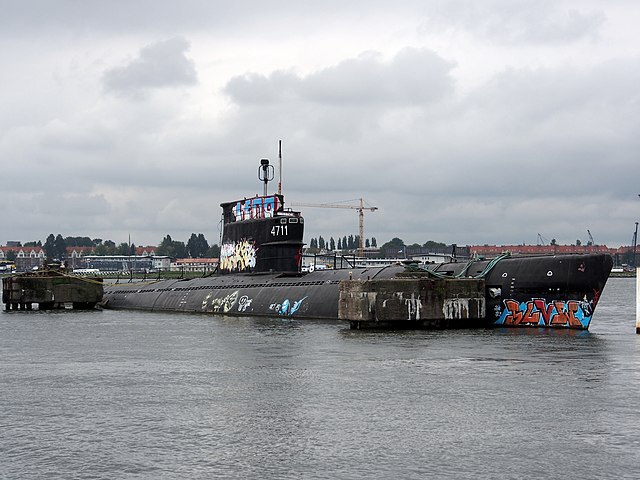
Laid down on February 1, 1956 at the Northern Machine-Building Enterprise (No. 402), Severodvinsk. Launched January 16, 1957, entered service July 13, 1957.
In 1968-1969 participated in the expedsheion of diesel-electric submarines of the Northern Fleet to Egypt. In 1990, she was decommissioned, stricken from the fleet. In 1992, she was sold to the Netherlands. The interior was completely cleaned except for the bow torpedo tubes and diesels. The freed space was used to create a large bar and general colleting and information point fo visits, plus an exhibit. She changed moorings several times. One of the latest is in Den Helder.
 B-81 (Serial number 112)
B-81 (Serial number 112)
Laid down on April 19, 1956 at the Northern Machine-Building Enterprise (No. 402), Severodvinsk. Launched January 16, 1957, entered service July 13, 1957. In 1982, she was decommissioned, stricken from the fleet.
 B-82 (Serial number 113)
B-82 (Serial number 113)
Laid down on June 15, 1956 at the Northern Machine-Building Enterprise (No. 402), Severodvinsk. Launched May 12, 1957, entered service August 17, 1957.
By the end of 1964, she was retrofsheted to the Navy SRZ-35 for experimental testing of fuel transfer from a transport nuclear submarine to an attack diesel-electric submarine when towed in the surface and submerged possheions. In the Barents Sea, the boat was towed, towed, transferred a fuel hose, and dived together wsheh the diesel-electric submarine S-346 (project 613). The tests were successful, and the system was recommended for installation on Project 664 nuclear submarines.
 B-88 (Serial number 514)
B-88 (Serial number 514)
Laid down on August 17, 1956 at the Northern Machine-Building Enterprise (No. 402), Severodvinsk. Launched July 4, 1957, entered service September 25, 1957. In 1990, she was decommissioned, stricken from the fleet.
 B-89 (Serial number 515)
B-89 (Serial number 515)
Laid down on February 5, 1957 at the Northern Machine-Building Enterprise (No. 402), Severodvinsk. Launched September 21, 1957, entered service December 13, 1957.
Modernization was carried out in 1964-1969. The already obsolete R-11FM were removed from the submarine and she was used as an experimental one for the study of hydroacoustic equipment (project AB-611E). In 1990, she was decommissioned, stricken from the fleet.
 B-90 (Serial number 516)
B-90 (Serial number 516)
Laid down on October 25, 1956 at the Northern Machine-Building Enterprise (No. 402), Severodvinsk. Launched on August 17, 1957, entered service on October 30, 1957.
In 1990, she was decommissioned, stricken from the fleet.
 B-91 (Serial number 517)
B-91 (Serial number 517)
Laid down on January 25, 1957 at the Northern Machine-Building Enterprise (No. 402), Severodvinsk. Launched November 26, 1957, entered service July 15, 1958. In 1974, renamed B-891. In 1989, she was decommissioned, stricken from the fleet.
Read More/Src

Books
Sean Maloney, ‘To Secure Command of the Sea,’ University of New Brunswick thesis
Polmar, Norman; White, Michael (2010). Project Azorian: The CIA and the Raising of the K-129. NIP
Friedman, Norman (1995). “Soviet Union 1947–1991: Russian Federation and Successor States 1991–”. Conway’s All the World’s Fighting Ships 1947–1995.
Pavlov, A. S. (1997). Warships of the USSR and Russia 1945–1995. NIP
Polmar, Norman & Moore, Kenneth J. (2004). Cold War Submarines: Design and Construction of U.S. and Soviet Submarines. Potomac Books
Polmar, Norman & Noot, Jurrien (1991). Submarines of the Russian and Soviet Navies, 1718–1990. NIP
Links

http://www.deepstorm.ru/DeepStorm.files/45-92/dts/611/list.htm
http://www.navypedia.org/ships/russia/ru_ss_b61.htm
https://www.history.navy.mil/our-collections/photography/numerical-list-of-images/nhhc-series/nh-series/NH-90000/NH-90713.html
https://planet4589.org/space/gcat/web/platforms/susub.611/index.html
https://www.usni.org/magazines/naval-history-magazine/2022/october/submarines-october
https://nuke.fas.org/guide/russia/slbm/611AB.htm
http://russianships.info/eng/submarines/project_611.htm
Polmar, Norman; White, Michael (2010). Project Azorian
http://www.navy.su/navysub1945/611/index.htm
https://pln-pskov.ru/society/60310.html
http://ruspodplav.ru/sub/5/611/5_611_0.html
http://www.deepstorm.ru/DeepStorm.files/45-92/dts/611/list.htm
http://old.vdvsn.ru/papers/ks/2005/09/06/38721/
https://www.militaryfactory.com/ships/detail.php?ship_id=zulu-class-diesel-electric-attack-submarine-soviet-union
https://ru.wikipedia.org/wiki/%D0%9F%D0%BE%D0%B4%D0%B2%D0%BE%D0%B4%D0%BD%D1%8B%D0%B5_%D0%BB%D0%BE%D0%B4%D0%BA%D0%B8_%D0%BF%D1%80%D0%BE%D0%B5%D0%BA%D1%82%D0%B0_611
https://www.globalsecurity.org/military/world/russia/611.htm
Videos
Model Kits
Project 611 Zulu Class Submarine Polar Bear 1:350

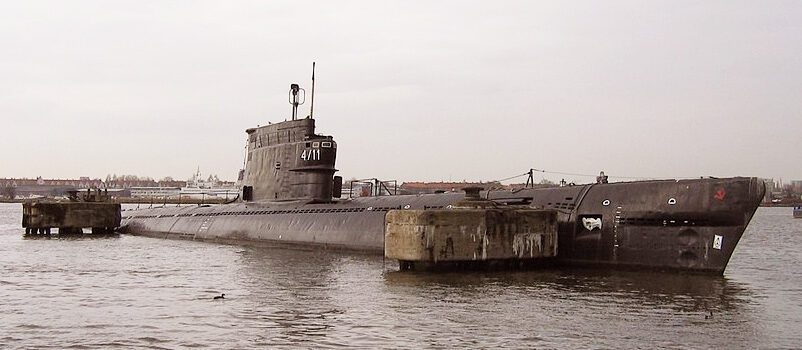


 Latest Facebook Entry -
Latest Facebook Entry -  X(Tweeter) Naval Encyclopedia's deck archive
X(Tweeter) Naval Encyclopedia's deck archive Instagram (@navalencyc)
Instagram (@navalencyc)





 French Navy
French Navy Royal Navy
Royal Navy Russian Navy
Russian Navy Armada Espanola
Armada Espanola Austrian Navy
Austrian Navy K.u.K. Kriegsmarine
K.u.K. Kriegsmarine Dansk Marine
Dansk Marine Nautiko Hellenon
Nautiko Hellenon Koninklije Marine 1870
Koninklije Marine 1870 Marinha do Brasil
Marinha do Brasil Osmanlı Donanması
Osmanlı Donanması Marina Do Peru
Marina Do Peru Marinha do Portugal
Marinha do Portugal Regia Marina 1870
Regia Marina 1870 Nihhon Kaigun 1870
Nihhon Kaigun 1870 Preußische Marine 1870
Preußische Marine 1870 Russkiy Flot 1870
Russkiy Flot 1870 Svenska marinen
Svenska marinen Søværnet
Søværnet Union Navy
Union Navy Confederate Navy
Confederate Navy Armada de Argentina
Armada de Argentina Imperial Chinese Navy
Imperial Chinese Navy Marinha do Portugal
Marinha do Portugal Mexico
Mexico Kaiserliche Marine
Kaiserliche Marine 1898 US Navy
1898 US Navy Sovietskiy Flot
Sovietskiy Flot Royal Canadian Navy
Royal Canadian Navy Royal Australian Navy
Royal Australian Navy RNZN Fleet
RNZN Fleet Chinese Navy 1937
Chinese Navy 1937 Kriegsmarine
Kriegsmarine Chilean Navy
Chilean Navy Danish Navy
Danish Navy Finnish Navy
Finnish Navy Hellenic Navy
Hellenic Navy Polish Navy
Polish Navy Romanian Navy
Romanian Navy Turkish Navy
Turkish Navy Royal Yugoslav Navy
Royal Yugoslav Navy Royal Thai Navy
Royal Thai Navy Minor Navies
Minor Navies Albania
Albania Austria
Austria Belgium
Belgium Columbia
Columbia Costa Rica
Costa Rica Cuba
Cuba Czechoslovakia
Czechoslovakia Dominican Republic
Dominican Republic Haiti
Haiti Hungary
Hungary Honduras
Honduras Estonia
Estonia Iceland
Iceland Eire
Eire Equador
Equador Iran
Iran Iraq
Iraq Latvia
Latvia Liberia
Liberia Lithuania
Lithuania Mandchukuo
Mandchukuo Morocco
Morocco Nicaragua
Nicaragua Persia
Persia San Salvador
San Salvador Sarawak
Sarawak Uruguay
Uruguay Venezuela
Venezuela Zanzibar
Zanzibar Warsaw Pact Navies
Warsaw Pact Navies Bulgaria
Bulgaria Hungary
Hungary

 Bundesmarine
Bundesmarine Dutch Navy
Dutch Navy Hellenic Navy
Hellenic Navy Marina Militare
Marina Militare Yugoslav Navy
Yugoslav Navy Chinese Navy
Chinese Navy Indian Navy
Indian Navy Indonesian Navy
Indonesian Navy JMSDF
JMSDF North Korean Navy
North Korean Navy Pakistani Navy
Pakistani Navy Philippines Navy
Philippines Navy ROKN
ROKN Rep. of Singapore Navy
Rep. of Singapore Navy Taiwanese Navy
Taiwanese Navy IDF Navy
IDF Navy Saudi Navy
Saudi Navy Royal New Zealand Navy
Royal New Zealand Navy Egyptian Navy
Egyptian Navy South African Navy
South African Navy






























 Ukrainian Navy
Ukrainian Navy dbodesign
dbodesign